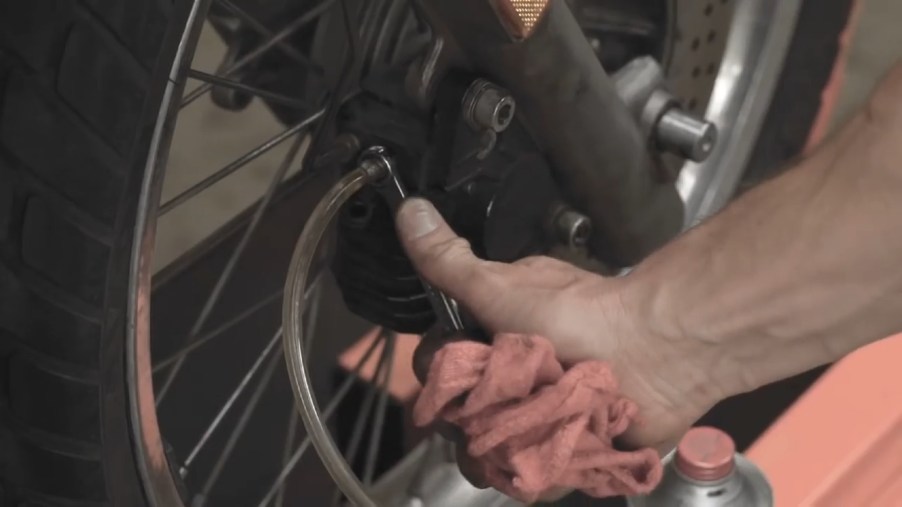
Are Motorcycle Brakes as Easy To Bleed as Car Brakes?
Some aspects of car and motorcycle maintenance differ noticeably between the two vehicles. A car, for example, doesn’t have to worry about chain lubrication. However, both bikes and cars need their engine oil changed. If your bike is water-cooled, it needs a coolant flush, just like a car. And both motorcycles and cars have brakes, with pads and rotors. Plus, every so often, you’ll need to bleed and/or flush those brakes. But is it the same whether you’re on a motorcycle or in a car?
Why would you want to bleed your motorcycle’s or your car’s brakes?

Cars and motorcycles use brake fluid, which, just like other fluids, needs to be replaced occasionally. Generally speaking, whether it’s for a bike or a car, the interval is roughly every two years, The Drive and Motorcyclist report. Though, if it’s changed colors or you’ve noticed a change in braking pressure, you should do change it quickly, Autoblog reports.
The brake fluid transmits pedal/lever pressure to the calipers and pads, Car and Driver explains. But as it does so, it picks up heat from the friction generated during braking. If you use your motorcycle’s or car’s brakes a lot, such as during a race, your brake fluid can actually boil, Road & Track explains.
This not only chemically changes the fluid, but it also introduces air into your brake lines. Plus, even if you don’t race, the fluid breaks down over time, absorbing ambient moisture and becoming corrosive, Hagerty explains. As more water gets in, the brake fluid’s boiling point drops, which makes it easier to boil, and the degradation accelerates.
Eventually, so much air gets into your motorcycle’s or car’s braking system that the brakes lose effectiveness. Your pedal/lever gets spongy or stops working completely.
Luckily, there is an easy remedy: regularly flush out and replace your motorcycle’s or car’s brake fluid. But to do so, you’ll also have to bleed your motorcycle’s or car’s brakes. If you don’t, you’ll trap air or debris in the system, causing the problems just described, Motorcyclist explains.
Luckily, if you want to bleed your motorcycle’s brakes, the procedure is virtually identical to the one used for cars, Revzilla explains. It’s just that, while bleeding a car’s brakes usually takes two people, the bike’s smaller size makes it a one-person job. Though if you have a power-operated or hand-operated vacuum pump, you can bleed your car’s brakes on your own, Haynes and Autozone report.
Is the procedure the same?
Assuming you want to replace the fluid, start by covering any painted surfaces so the brake fluid doesn’t damage them. Then, remove the cap on your master cylinder—which, on a bike, maybe on the handlebars—and draw out some of the old fluid. Next, fill it with fresh fluid. Don’t replace the cap too securely, because you’ll be adding more fluid throughout the process.
After that, find each brake caliper’s bleed screw; you’ll be loosening them one at a time. Generally speaking, you should start with the one furthest from the master cylinder, Revzilla and Car and Driver report. But check your owner’s manual or service manual to be sure.
When you’ve loosened the screw, attach a length of clear tubing to it. Put the other end of the tubing in a catch can, which can be as simple as an old plastic soda bottle. Or, if you’re using a vacuum pump, the pump container. Make sure the catch can is above the bleed screw, so air or fluid doesn’t rush back in.
Then, either you or your assistant needs to pull/push on the brakes as hard as possible. This will force the old brake fluid and any air out of the brake lines and into the catch can. You will be losing fluid doing this, hence the catch can and loosely-capped master cylinder. Once no more air or fluid is escaping, close the bleeder screw, and release the brake pedal/lever. Check to see if you need to add more fluid to the brake master cylinder.
Repeat this until you see the new brake fluid in the tubing, and/or there’s no more air escaping. Then move on to the next brake caliper. This is how you bleed your car’s or motorcycle’s brakes.
Is there a difference between motorcycle and car brake fluid?
While you have to bleed your brakes after replacing the fluid, it can be done without a full flush. If you’re noticing your brake pedal or lever feeling spongy, a good brake bleed often fixes the problem. Though if it doesn’t, that might mean a problem elsewhere, such as the master cylinder or brake lines themselves.
However, whether you’re doing a full flush or a quick brake bleed, you’ll need a good supply of brake fluid. Car and bike brake fluid is functionally the same, CarTreatments reports, though each specific make and model has its own required type.
This is based on the fluid’s DOT rating, which describes its boiling point and chemistry, Motorcycle Cruiser explains. DOT 3, 4, and 5.1 are all glycol-based fluids, with the higher numbers indicating a higher boiling point, Motorcyclist reports. DOT 5.1, though, is really only intended for very extreme scenarios; most bikes stick to DOT 4.
DOT 5 fluid has a higher boiling point than DOT 4, but it’s a silicone-based fluid. However, while that means you can’t mix it with the others, it doesn’t degrade paint like glycol-based fluids, Hemmings reports. Plus, silicone-based brake fluids aren’t hygroscopic, meaning they don’t absorb water like the glycol-based ones do.
Follow more updates from MotorBiscuit on our Facebook page.


